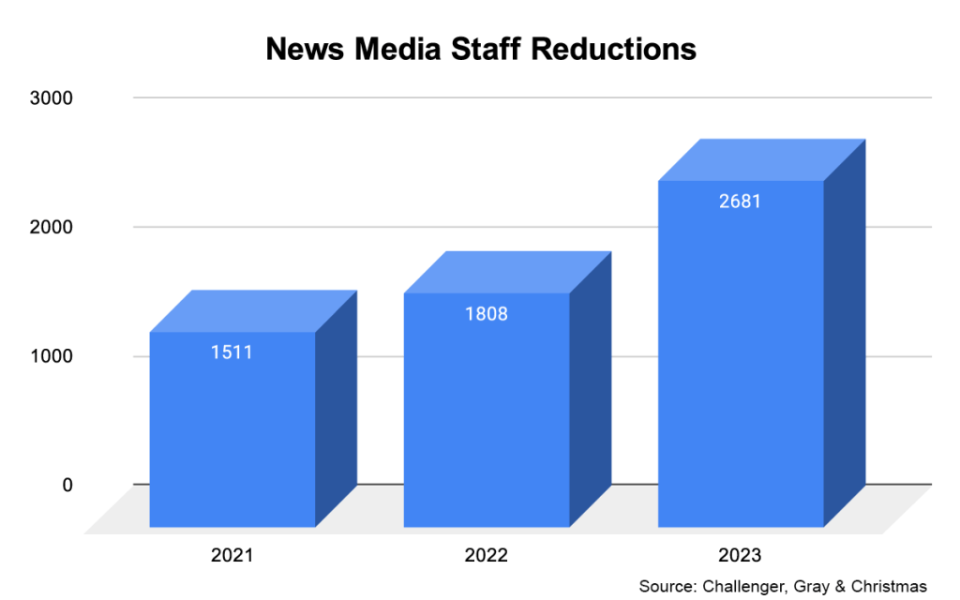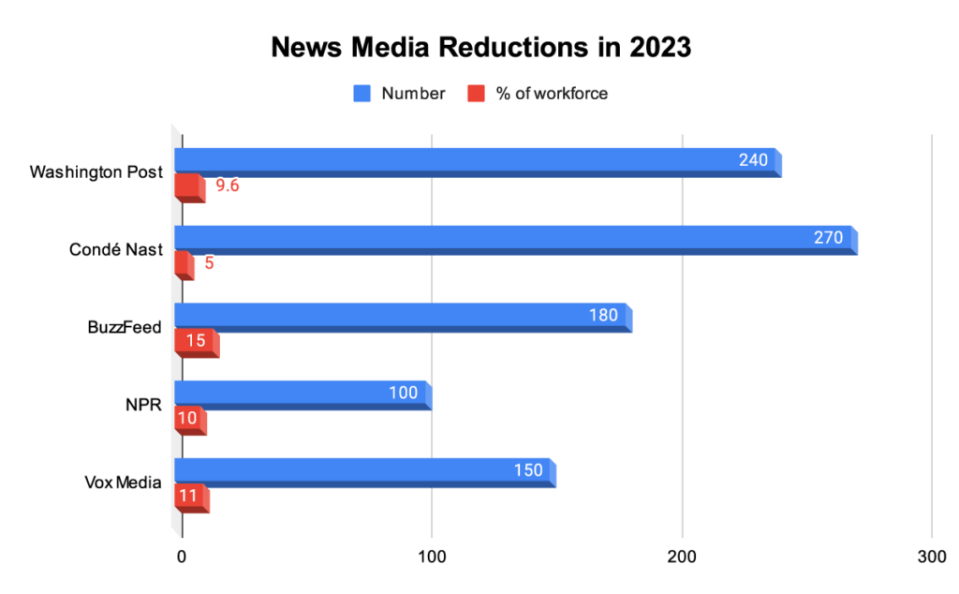As More Media Layoffs Ring in the New Year, Americans Face Prospect of ‘News Deserts’ | Analysis
The media industry has been rocked this holiday season by news of newsroom layoffs as outlets downsize to combat volatility in advertising, after an already-brutal year of job cuts.
In the last month alone, Condé Nast, G/O Media, Vice Media and Vox Media have all cut staff, most of whom already had layoffs earlier this year. (Vice filed for bankruptcy in June.)
Broadcast, print and digital outlets collectively saw 2,681 journalism job cuts in 2023, up 48% from 1,808 in 2022 and 77% from 1,511 in 2021, according to a report from employment firm Challenger, Gray & Christmas.
With a collapsing advertising-revenue model and more media companies experimenting with artificial intelligence to create content, the outlook for journalism is dimming, media analysts told TheWrap. The decline underscores the need for the public and even governments to fund news gathering if it is to survive in its current form and avoid widespread “news deserts,” they said.
“All available evidence suggests that the commercial future for journalism is especially dire,” Victor Pickard, a professor of media policy and political economy at the University of Pennsylvania’s Annenberg School for Communication, told TheWrap. “We cannot simply let the market drive local journalism into the ground. I expect to see more legislative efforts, especially at state government levels, aimed at shoring up and even expanding local journalism.”

To that end, one bright spot amid the gloomy outlook has been the growth of nonprofit newsrooms, which increased in number by 17% in 2022 and boosted revenues 19% to nearly $500 million between 2021 and 2022, according to a report published this May by The Institute for Nonprofit News.
Last week, Mother Jones and the Center for Investigative Reporting, two San Francisco based non-profit investigative organizations, said they were merging and would employ 70 staffers. The combined outlets have $21 million in funding commitments over the next three years, Monika Bauerlein, the CEO of Mother Jones, said in a statement.
“Community-based online media, and nonprofit media more broadly, have been relatively insulated from the layoff march,” Jesse Holcomb, an assistant professor of journalism and communication at Calvin University, told TheWrap. “Those newsrooms are often small, lean, and increasingly revenue diverse.”
Yet even some of them have felt the same industry pressures. In August, The Texas Tribune — an award-winning leader in the nonprofit journalism push — laid off 11 staffers, the outlet’s first job cuts in its 14-year history.
Advertising losses deepen
Heading into 2024, legacy media, which rely on digital and print advertising, are facing tough decisions about whether to cut staff or sell off unprofitable assets.
In November, G/O Media shuttered female-forward publication Jezebel after failing to find a buyer for the outlet, citing a lack of advertising traction for the site. The company laid off 23 editorial staffers, with Gizmodo and The Onion also impacted. In the announcement to staffers, CEO Jim Spanfeller cited challenging market conditions for the “very difficult decision” to trim the workforce. (Paste Magazine acquired Jezebel at the end of November and resumed publication)
Condé Nast said in early November it would reduce its staff by 5%, or around 270 employees. CEO Roger Lynch said the company is having to respond to digital advertising pressures and a decline in social media traffic, according to an internal memo. The job cuts, which officially began at the end of November, are impacting The New Yorker and other brands under the Condé Nast umbrella.
Underpinning the media slide is a darkening advertising outlook. U.S. newspaper publishers are expected to lose $2.4 billion in advertising investment between 2021 and 2026, mostly related to less print advertising, according to a 2022 report from the consulting firm PwC. Print advertising that fell to $7 billion in 2021 will drop to $4.9 billion by 2026, the consultancy said, with digital advertising growth only expected to increase by 1% in that same period — which is not enough to recoup overall lost ad revenue.
Traditional media outlets that still rely largely on ad revenue for income are now having to adjust strategies to “gain a wider reach,” Ashanti Blaize-Hopkins, the national president of the Society of Professional Journalists, told TheWrap.

Big Tech companies, including Alphabet, Meta and Amazon, continue to control the lion’s share — at least 70% by most estimates — of digital advertising. The Justice Department sued Google (now called Alphabet) in January on antitrust grounds for allegedly monopolizing digital advertising technologies, saying the tech giant pockets on average more than 30% of the advertising dollars that flow through its technology products. And as news consumers shift their focus to social media, popular Chinese-owned app TikTok is flexing its muscles, asking advertisers to spend at least 50% more in 2024, The Information reported.
But even if platforms such as Google were to redistribute more advertising revenues back to news publishers, those revenues are “highly unlikely to return” to previous levels, Pickard said.
Wall Street financial players have continued to seize on turnaround opportunities for struggling media companies. In a so-called vulture capitalist strategy, more hedge funds and private equity firms are purchasing news outlets and then “gutting newsroom staffs,” Blaize-Hopkins said.
And now, under pressure from Wall Street and Big Tech, generative AI has begun to infiltrate the media landscape. Media analysts expect more controversies to occur like the recent debacle over Sports Illustrated using AI to create fake writer profiles that generated articles, which infuriated the publication’s writers guild. (Three top executives were fired in the wake of the scandal.)
Investment needed to avoid ‘news deserts’
The decline of media outlets is creating “news deserts” where local media once operated, which will isolate citizens much like “food deserts” do from a lack of nearby grocery stores.
“The news deserts metaphor will soon cease to make much sense because we all will be living in such an area,” Pickard said. “News deserts will encompass the entire country.”
A research study in 2022 by Northwestern University’s Medill School found that some 2,500 dailies and weeklies have shut down since 2005. The study predicted that a third of American newspapers that existed roughly two decades ago will be out of business by 2025.
This year that annual report cited 204 counties that currently are news deserts, with no newspapers, local digital sites, public radio newsrooms or ethnic publications. And Medill identified another 228 counties at substantial risk of becoming news deserts in coming years.
Heading into another presidential election year, news audiences are expected to grow to some degree. But analysts who spoke to TheWrap fear it may not be enough to slow the layoff train. A “small election-year bump,” could benefit media companies, Pickard said. However, “even this is unlikely to make much of a difference.”
The general public will need to take responsibility to “help stabilize the industry,” Blaize-Hopkins said. “Making sure we invest in local news – whether monetarily or by consuming local news content – is crucial.”
“The health of the journalism industry is closely tied to the health of our democracy,” Blaize-Hopkins added. “When layoffs happen, the public becomes less informed, which puts our very democracy at risk.”
The post As More Media Layoffs Ring in the New Year, Americans Face Prospect of ‘News Deserts’ | Analysis appeared first on TheWrap.

